Ronda is a town in Malaga in Spain. Set in and around a deep gorge spanned by an impressive bridge, the relaxing atmosphere here is a great break from some of the more tourist-ridden places on the south coast of Spain, however it can still be packed with day-trippers from the Costa del Sol, especially during the peak summer months.
Ronda was first settled by the early Celts, and later inhabited by Phoenicians, Greeks, and Romans. The Moors left an indelible imprint in the city, which only fell to the Christian reconquista in 1485. In more recent times, the town has hosted a number of well-known writers, including Ernest Hemingway, Orson Welles, James Joyce, and the German poet Rainer Maria Rilke.
Ronda is divided into three neighbourhoods: the more modern Mercadillo, with the bus and train stations and other services; La Ciudad, the old Moorish quarter which has been largely preserved; and the Barrio de San Francisco. The town makes a good base for outdoor pursuits, including hiking, canoeing and river kayaking, and mountain biking.
- Tourist Information Office, Paseo Blas Infante, s/n, +34 952 18 71 19. M-F 10:00-18:00/19:00 (winter/summer), Sa 10:00-14:00, 15:00-17:00, Su and holidays 10:00-14:30. Can help with accommodation and offer suggestions for sightseeing. Has hiking maps for sale, and bus and train schedules are posted in the window.
- Ernest Hemingway, For Whom the Bell Tolls. The execution scene in Chapter 10 is based upon events which took place in Ronda during the Spanish Civil War.
Ernest Hemingway, For Whom the Bell Tolls. The execution scene in Chapter 10 is based upon events which took place in Ronda during the Spanish Civil War.
Tourist Information Office, Paseo Blas Infante, s/n, +34 952 18 71 19. M-F 10:00-18:00/19:00 (winter/summer), Sa 10:00-14:00, 15:00-17:00, Su and holidays 10:00-14:30. Can help with accommodation and offer suggestions for sightseeing. Has hiking maps for sale, and bus and train schedules are posted in the window.
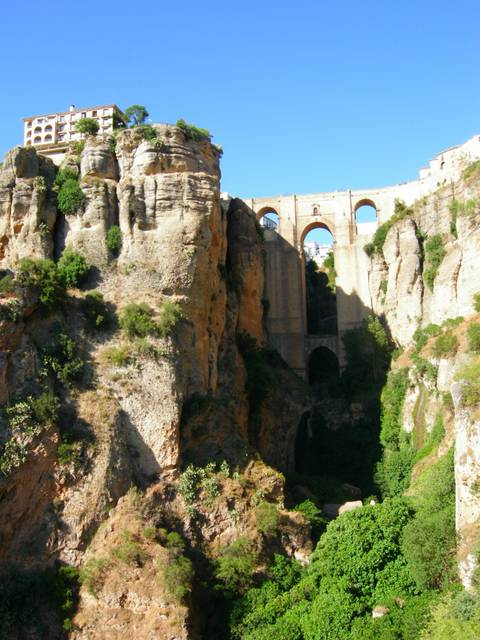
- Puente Nuevo. This large and incredible bridge over the Tajo gorge, finished in 1793, is Ronda's principal attraction. The bridge is 70 m long and 98 m high, equivalent to a 30-floor building, and connects the quarter of La Ciudad with the Mercadillo. It was built following the collapse of an earlier bridge from 1735; this bridge had a single arch of 35m but collapsed six years after construction, killing 50 people. There are beautiful views from here of the Sierra de Grazalema to the west. A small museum is inside.
-KeCzd.medium.jpg)
- Plaza de Toros, Calle Virgen de la Paz, 15, +34 952 874 132 (tickets). Nov-Feb 10:00-18:00, Mar 10:00-19:00, Apr-Sep 10:00-20:00, Oct 10:00-19:00; closed on bullfighting days in September. The oldest and one of the most highly regarded of Spain's bull rings, built in 1785 in the neoclassical style. This is considered to be the cradle of modern Spanish bullfighting, where Pedro Romero (1754-1839) developed a new style of fighting bulls on foot (and not from horseback as had been done previously); he also was the first to begin using a red cloth. Romero retired after he had killed 5000 bulls and remained uninjured. His son and grandson carried on the tradition. €6.50, €8 (with audioguide).
- Also located inside is a bullfighting museum.
- Parque Alameda. A nice park with shady trees and ample walking space. You can see wonderful panoramas from the viewing platforms.
Plaza de Toros, Calle Virgen de la Paz, 15, +34 952 874 132 (tickets). Nov-Feb 10:00-18:00, Mar 10:00-19:00, Apr-Sep 10:00-20:00, Oct 10:00-19:00; closed on bullfighting days in September. The oldest and one of the most highly regarded of Spain's bull rings, built in 1785 in the neoclassical style. This is considered to be the cradle of modern Spanish bullfighting, where Pedro Romero (1754-1839) developed a new style of fighting bulls on foot (and not from horseback as had been done previously); he also was the first to begin using a red cloth. Romero retired after he had killed 5000 bulls and remained uninjured. His son and grandson carried on the tradition. €6.50, €8 (with audioguide).
- Also located inside is a bullfighting museum.
Parque Alameda. A nice park with shady trees and ample walking space. You can see wonderful panoramas from the viewing platforms.
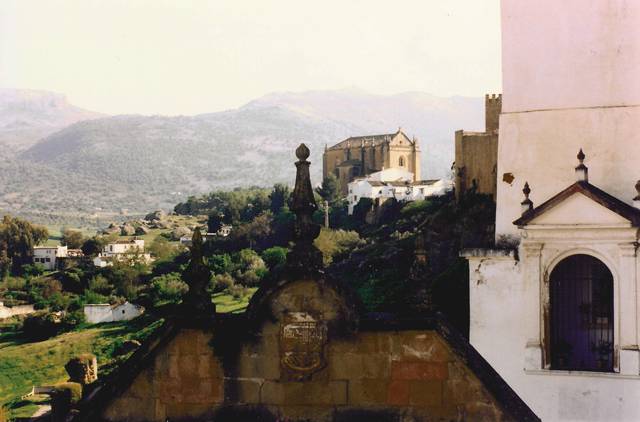
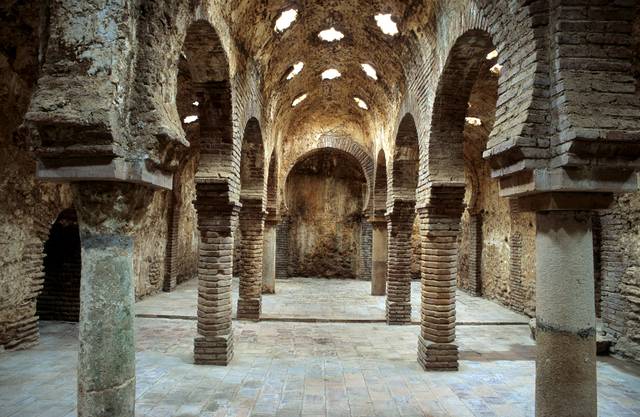
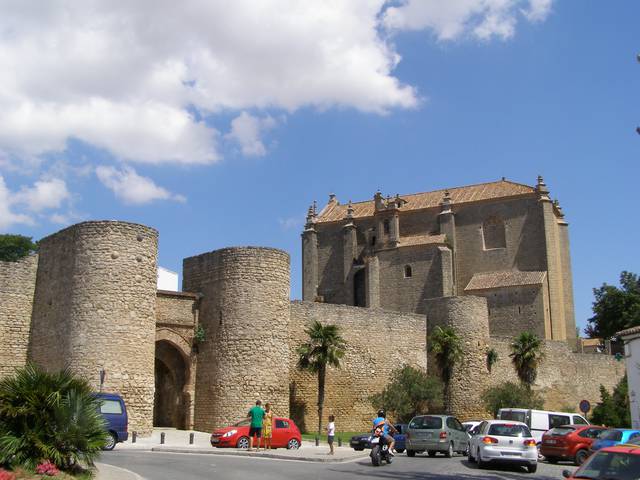 The old district of Ronda, beyond the new bridge. Full of twisting, narrow streets.
The old district of Ronda, beyond the new bridge. Full of twisting, narrow streets.
- Iglesia de Santa Maria la Mayor. M-Sa 10:00-19:00; Su 10:00-12:30, 14:00-19:00. This is most important church in Ronda, built after the reconquista on the site of town's former principal Moorish mosque, with construction lasting from 1485 until the end of the 17th century. The only features remaining from the mosque are the arch of the mirhab and a section of its wall covered with stucco, both hidden behind the retable of the main altar; additionally the former minaret was converted to the bell tower. This is a Gothic-style church that, inside, has elements of the Baroque and Rococo, as the church was partly rebuilt following the earthquake of 1580. The walnut and cedar choir seating dates from the Renaissance period. An unusual feature is a balcony on the front side of the church which faces the Ayuntamiento (city hall). €4 (adults), €3 (seniors), €2 (children under 10/Ronda residents).
- Iglesia de Espíritu Santo. M-Sa 10:00-14:00. Construction of this church began in 1485 and was completed 20 years later. The church has a nave with three vaults, and from the outside has the appearance of a fortification. €1 (adults and children over 10), free (children under 10).
- Palacio de Mondragón, Plaza de Mondragón, 5, +34 952 16 11 02. M-F 10:00-19:00, Sa Su 10:00-15:00. A former Moorish palace with beautiful courtyards, a terrace, and a fantastic view. Today it houses a small museum dedicated to the history of the town. €3.
- Puente Viejo, Calle Molino de Alarcón. This small bridge was the means of crossing the Tajo before the completion of the newer, larger one.
- Arco de Felipe V, Calle Real. A beautiful arch, named for Phillip the Fifth.
- Baños Árabes, Cuesta de Santo Domingo. M-F 10:00-19:00, Sa Su 10:00-15:00. A 13th-century Moorish public bathhouse, considered to be one of the best-preserved in Spain. The vaulting is particularly noteworthy. €3, free on Mondays.
- Museo de Peinado, Calle de San Juan Bosco, 78 (Plaza del Gigante, +34 952 87 15 85. M-F 10:00-17:00, Sa and holidays 10:00-15:00; closed 25 Dec, 1 Jan and 6 Jan. Joaquin Peinade was born in 1898 in Ronda and died in 1975 in Paris. Artistically he was a descendant of Cézanne and spiritual son of Picasso, and he is often described as the most elegant of the painters from the so-called 'Spanish School' of Paris. Paintings from the painter's career, which spanned from 1923-1974 are on display. The collection includes more than 190 pieces, including some lesser-known works from the painter's private collection. Particularly noteworthy paintings include Still Life with Pears, Figure with Dove, Fruit Basket, and Female Nude. The museum is housed in a palace named after the last Aztec king, in the center of La Ciudad. The building from the 19th century has mixed architectural influences, and both courtyards are worth looking at. €4 (adults), €2 (seniors/students), free (children under 14); free on Tu afternoons.
- Museo Lara, Calle Armiñán, 29, +34 952 87 12 63. Nov-May daily 11:00-19:00, Jun-Oct 11:00-20:00. Recently opened following the initiative of Juan Lara Jurado, this museum houses a collection of more than 2000 works of art and antiquities. It is the largest private museum in Andalusia. €4 (adults), €2 (students/seniors/Ronda residents).
- Museo Bandolero, Calle Armiñan, 65, +34 952 87 77 85. Daily including holidays: autumn/winter 11:00-19:00, spring/summer 11:00-20:30. The only museum in Spain devoted to the history of bandits (bandoleros), which were widespread throughout the region in the 19th century. €3.75 (adults), €2.80 (seniors/students/youth card).
- Puerta de Almocábar. Ronda's primary Moorish gate separates La Ciudad from the Barrio de San Francisco. There are a couple sets of stairs leading to the top of the wall and to the watchtowers, which offer great views of the surrounding area. Free.
- Casa del Gigante, Plaza del Gigante, 5. So-named for the stone figure placed at the corner. The house dates from the 14 and 15th centuries, and has a number of Moorish architectural elements, including horseshoe arches, ornate stucco work, and decorative wooden ceilings. The building has been carefully restored and is open to the public.
- Palacio del Marqués de Salvatierra, Calle Real, 2. A Renaissance mansion with an unusual façade of four Peruvian Indians. The building is still a private residence and is not open to the public, but can be viewed from the outside.
- Casa de San Juan Bosco, Calle Tenorio, 20. Built in the early 20th century and accessed via a tiled entryway, the house contains a large collection of regional ceramics as well as 19th-century tapestries. A landscaoed terrace provides wonderful views of the gorge and the Puente Nuevo. Entry fee.
Iglesia de Santa Maria la Mayor. M-Sa 10:00-19:00; Su 10:00-12:30, 14:00-19:00. This is most important church in Ronda, built after the reconquista on the site of town's former principal Moorish mosque, with construction lasting from 1485 until the end of the 17th century. The only features remaining from the mosque are the arch of the mirhab and a section of its wall covered with stucco, both hidden behind the retable of the main altar; additionally the former minaret was converted to the bell tower. This is a Gothic-style church that, inside, has elements of the Baroque and Rococo, as the church was partly rebuilt following the earthquake of 1580. The walnut and cedar choir seating dates from the Renaissance period. An unusual feature is a balcony on the front side of the church which faces the Ayuntamiento (city hall). €4 (adults), €3 (seniors), €2 (children under 10/Ronda residents).
Iglesia de Espíritu Santo. M-Sa 10:00-14:00. Construction of this church began in 1485 and was completed 20 years later. The church has a nave with three vaults, and from the outside has the appearance of a fortification. €1 (adults and children over 10), free (children under 10).
Palacio de Mondragón, Plaza de Mondragón, 5, +34 952 16 11 02. M-F 10:00-19:00, Sa Su 10:00-15:00. A former Moorish palace with beautiful courtyards, a terrace, and a fantastic view. Today it houses a small museum dedicated to the history of the town. €3.
Puente Viejo, Calle Molino de Alarcón. This small bridge was the means of crossing the Tajo before the completion of the newer, larger one.
Arco de Felipe V, Calle Real. A beautiful arch, named for Phillip the Fifth.
Baños Árabes, Cuesta de Santo Domingo. M-F 10:00-19:00, Sa Su 10:00-15:00. A 13th-century Moorish public bathhouse, considered to be one of the best-preserved in Spain. The vaulting is particularly noteworthy. €3, free on Mondays.
Museo de Peinado, Calle de San Juan Bosco, 78 (Plaza del Gigante, +34 952 87 15 85. M-F 10:00-17:00, Sa and holidays 10:00-15:00; closed 25 Dec, 1 Jan and 6 Jan. Joaquin Peinade was born in 1898 in Ronda and died in 1975 in Paris. Artistically he was a descendant of Cézanne and spiritual son of Picasso, and he is often described as the most elegant of the painters from the so-called 'Spanish School' of Paris. Paintings from the painter's career, which spanned from 1923-1974 are on display. The collection includes more than 190 pieces, including some lesser-known works from the painter's private collection. Particularly noteworthy paintings include Still Life with Pears, Figure with Dove, Fruit Basket, and Female Nude. The museum is housed in a palace named after the last Aztec king, in the center of La Ciudad. The building from the 19th century has mixed architectural influences, and both courtyards are worth looking at. €4 (adults), €2 (seniors/students), free (children under 14); free on Tu afternoons.
Museo Lara, Calle Armiñán, 29, +34 952 87 12 63. Nov-May daily 11:00-19:00, Jun-Oct 11:00-20:00. Recently opened following the initiative of Juan Lara Jurado, this museum houses a collection of more than 2000 works of art and antiquities. It is the largest private museum in Andalusia. €4 (adults), €2 (students/seniors/Ronda residents).
Museo Bandolero, Calle Armiñan, 65, +34 952 87 77 85. Daily including holidays: autumn/winter 11:00-19:00, spring/summer 11:00-20:30. The only museum in Spain devoted to the history of bandits (bandoleros), which were widespread throughout the region in the 19th century. €3.75 (adults), €2.80 (seniors/students/youth card).
Puerta de Almocábar. Ronda's primary Moorish gate separates La Ciudad from the Barrio de San Francisco. There are a couple sets of stairs leading to the top of the wall and to the watchtowers, which offer great views of the surrounding area. Free.
Casa del Gigante, Plaza del Gigante, 5. So-named for the stone figure placed at the corner. The house dates from the 14 and 15th centuries, and has a number of Moorish architectural elements, including horseshoe arches, ornate stucco work, and decorative wooden ceilings. The building has been carefully restored and is open to the public.
Palacio del Marqués de Salvatierra, Calle Real, 2. A Renaissance mansion with an unusual façade of four Peruvian Indians. The building is still a private residence and is not open to the public, but can be viewed from the outside.
Casa de San Juan Bosco, Calle Tenorio, 20. Built in the early 20th century and accessed via a tiled entryway, the house contains a large collection of regional ceramics as well as 19th-century tapestries. A landscaoed terrace provides wonderful views of the gorge and the Puente Nuevo. Entry fee.
Puente Nuevo. This large and incredible bridge over the Tajo gorge, finished in 1793, is Ronda's principal attraction. The bridge is 70 m long and 98 m high, equivalent to a 30-floor building, and connects the quarter of La Ciudad with the Mercadillo. It was built following the collapse of an earlier bridge from 1735; this bridge had a single arch of 35m but collapsed six years after construction, killing 50 people. There are beautiful views from here of the Sierra de Grazalema to the west. A small museum is inside.
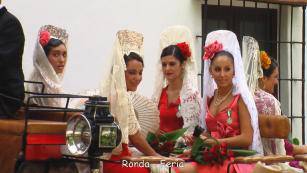
- Interpretation Center of Ronda Wine, Calle Gonzalez Campos, 2, +34 95287 97 35. Daily 10:00-20:00. Old winery and now a museum of wine, offering wine tastings and vineyard tours. €4-10.
- La Casa Del Rey Moro, Calle de Santo Domingo, 9 (cross the famous bridge into La Cuidad, take the first proper street to the left; La Casa is on the left, +34 952 18 72 00. Pretty gardens and a castle undergoing renovation. The main attraction, however, is the water mine – underground steps leading all the way down to the bottom of the gorge.
- Feria de Pedro Romero. Beginning of September. Celebrated with parades and bullfights.
- Hiking. There are a number of hiking trails around Ronda, including eight with trailheads beginning in Ronda. The tourist information office carries maps and trail descriptions for €1/trail; alternatively their website has a comprehensive list of routes with GPS coordinates and trail descriptions available for free download. One of the most popular routes is Route 3 (SL-A 38), which descends to the bottom of the Tajo Gorge passing by several excellent viewpoints of the Puente Nuevo. (A word of caution is advised, though, as if there is an extended dry spell, the gorge can stink because sewage is still released into the river.)
Interpretation Center of Ronda Wine, Calle Gonzalez Campos, 2, +34 95287 97 35. Daily 10:00-20:00. Old winery and now a museum of wine, offering wine tastings and vineyard tours. €4-10.
La Casa Del Rey Moro, Calle de Santo Domingo, 9 (cross the famous bridge into La Cuidad, take the first proper street to the left; La Casa is on the left, +34 952 18 72 00. Pretty gardens and a castle undergoing renovation. The main attraction, however, is the water mine – underground steps leading all the way down to the bottom of the gorge.
Feria de Pedro Romero. Beginning of September. Celebrated with parades and bullfights.
Hiking. There are a number of hiking trails around Ronda, including eight with trailheads beginning in Ronda. The tourist information office carries maps and trail descriptions for €1/trail; alternatively their website has a comprehensive list of routes with GPS coordinates and trail descriptions available for free download. One of the most popular routes is Route 3 (SL-A 38), which descends to the bottom of the Tajo Gorge passing by several excellent viewpoints of the Puente Nuevo. (A word of caution is advised, though, as if there is an extended dry spell, the gorge can stink because sewage is still released into the river.)
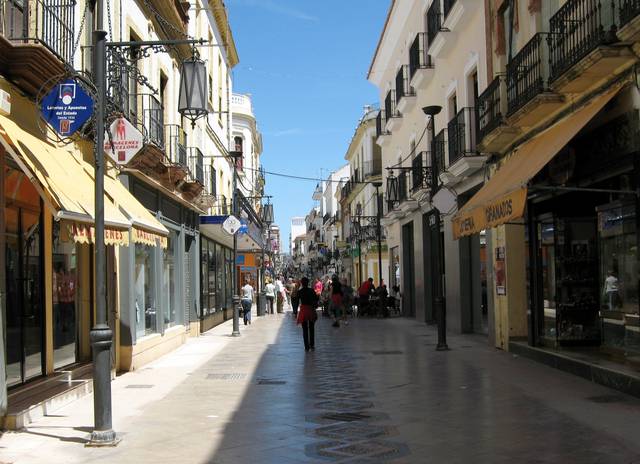 Ronda is noted for distinctive white enamelled ceramic, which is used for everyday domestic ware. There are plenty of ATMs dotted about the Mercadillo, or the main commercial district.
Ronda is noted for distinctive white enamelled ceramic, which is used for everyday domestic ware. There are plenty of ATMs dotted about the Mercadillo, or the main commercial district.
- Carretera Espinel. The main pedestrian shopping street, stretching from the bullring to Avenida Málaga. Shops here cater not only to tourists but also the town's inhabitants, and you can find everything here to meet your daily needs for reasonable prices. (Trivia: "La bola" means "ball" in Spanish; the street earned its nickname when, after a heavy snowfall, a group of citizens rolled a large snowball down its slope.)
Carretera Espinel. The main pedestrian shopping street, stretching from the bullring to Avenida Málaga. Shops here cater not only to tourists but also the town's inhabitants, and you can find everything here to meet your daily needs for reasonable prices. (Trivia: "La bola" means "ball" in Spanish; the street earned its nickname when, after a heavy snowfall, a group of citizens rolled a large snowball down its slope.)
Avoid the restaurants in the tourist area during the day, as they are overpriced and often only full of other tourists! Look for smaller cafes and bars. A quick breakfast usually consists of toast (pan tostada) and coffee (cafe con leche – coffee with milk; be sure to add the pack of sugar always served with it for a real treat.) If you are looking for an inexpensive snack or lunch, any bar will be able to make you a sandwich (bocadillo) with your choice of ham, cheese, or tomato. Also, look for bakeries (pastelerias), as Spain has some of the finest pastries around.
- Pizzeria Telepizza, Calle Jerez, 9 (Mercadillo, +34 952 87 17 18. Part of a Spanish chain.
Pizzeria Telepizza, Calle Jerez, 9 (Mercadillo, +34 952 87 17 18. Part of a Spanish chain.
- Cafe Bar Bodega San Francisco, Plaza Ruedo Alameda, 32 (Barrio de San Francisco, +34 952 87 81 62. M-W F-Su 11:00-01:00. Good place for eating authentic Andalusian food, just outside the ancient walls of the old town.
- Patatín-Patatán, Calle Lorenzo Borrego, 7 (Mercadillo, near E side of Plaza Socorro, +34 647 23 66 99. M Tu Th-Su 11:00-16:00, 19:00-23:00. A popular family-run tapas bar with good seafood and chorizo.
- Restaurante Don Javier, Calle Virgen de la Paz, 7 (Mercadillo, +34 952 87 20 20.
- Restaurante Don Miguel, Plaza de España, 4-5 (Mercadillo, Plaza de España, +34 952 87 10 90. Has a number of tables on the terrace with views of the bridge.
Cafe Bar Bodega San Francisco, Plaza Ruedo Alameda, 32 (Barrio de San Francisco, +34 952 87 81 62. M-W F-Su 11:00-01:00. Good place for eating authentic Andalusian food, just outside the ancient walls of the old town.
Patatín-Patatán, Calle Lorenzo Borrego, 7 (Mercadillo, near E side of Plaza Socorro, +34 647 23 66 99. M Tu Th-Su 11:00-16:00, 19:00-23:00. A popular family-run tapas bar with good seafood and chorizo.
Restaurante Don Javier, Calle Virgen de la Paz, 7 (Mercadillo, +34 952 87 20 20.
Restaurante Don Miguel, Plaza de España, 4-5 (Mercadillo, Plaza de España, +34 952 87 10 90. Has a number of tables on the terrace with views of the bridge.
- Albacara Restaurant, +34 952 16 11 84, +34 952 87 38 55. There are several tables on a terrace with views of the Puente Nuevo.
- Sol y Sombra, Calle Virgen de la Paz, 26 (Mercadillo, a short distance down the street from the bull ring, +34 952 18 71 76.
Albacara Restaurant, +34 952 16 11 84, +34 952 87 38 55. There are several tables on a terrace with views of the Puente Nuevo.
Sol y Sombra, Calle Virgen de la Paz, 26 (Mercadillo, a short distance down the street from the bull ring, +34 952 18 71 76.
Near Ronda, high quality wines are produced in small wineries. Also you can find "Anis del Tajo".
- Huskies Sport Bar, Calle Molino, 1, +34 661 46 49 77. This bar is run by a man who used to live in America and it's decently priced and has a good atmosphere.
Huskies Sport Bar, Calle Molino, 1, +34 661 46 49 77. This bar is run by a man who used to live in America and it's decently priced and has a good atmosphere.
Ronda is a district hub for the bus services to other pueblo blanco towns and villages such as Montejaque, Benaojan and Zahara la Sierra. Most of these villages have at least one weekday service, while others have up to three services a day.
- Cueva de Pileta, +34 952 16 73 43. Oct-Mar: daily 10:00-13:00, 16:00-17:00; Apr-Sep: daily 10:00-13:00, 16:00-18:00. This cave, discovered in 1905, has a number of cave paintings dating from the Neolithic period. Tours are available upon arrival, and last about one hour. Warm dress and sturdy shoes are recommended; no cameras or cell phones permitted. €8 adults, €5 children 5-10.
- Acinipo. Tu-Sa 10:00-17:00, Su 09:00-14:00. The remains of a Roman city, destroyed in 429 CE by the Vandals. The site includes the remains of a Roman theatre as well as Roman baths. Free.
Cueva de Pileta, +34 952 16 73 43. Oct-Mar: daily 10:00-13:00, 16:00-17:00; Apr-Sep: daily 10:00-13:00, 16:00-18:00. This cave, discovered in 1905, has a number of cave paintings dating from the Neolithic period. Tours are available upon arrival, and last about one hour. Warm dress and sturdy shoes are recommended; no cameras or cell phones permitted. €8 adults, €5 children 5-10.
Acinipo. Tu-Sa 10:00-17:00, Su 09:00-14:00. The remains of a Roman city, destroyed in 429 CE by the Vandals. The site includes the remains of a Roman theatre as well as Roman baths. Free.
